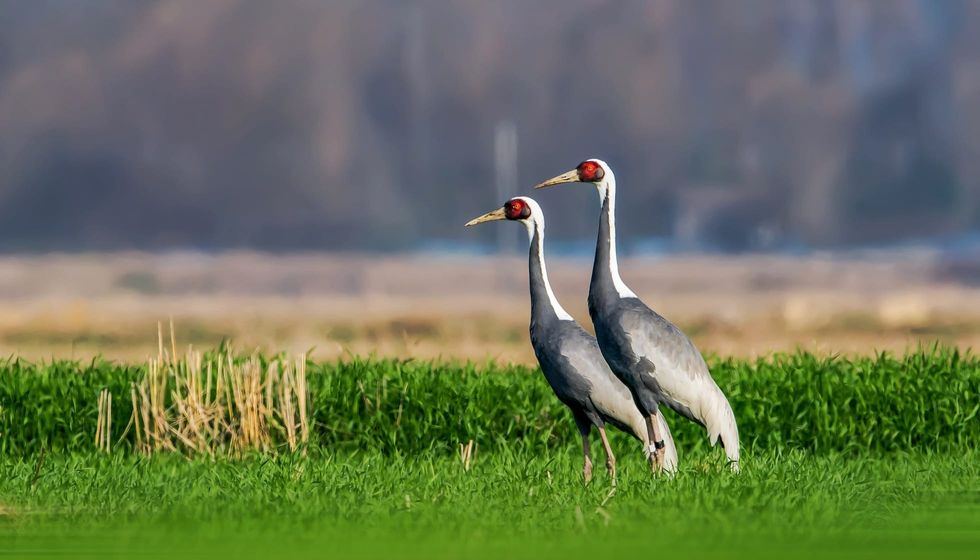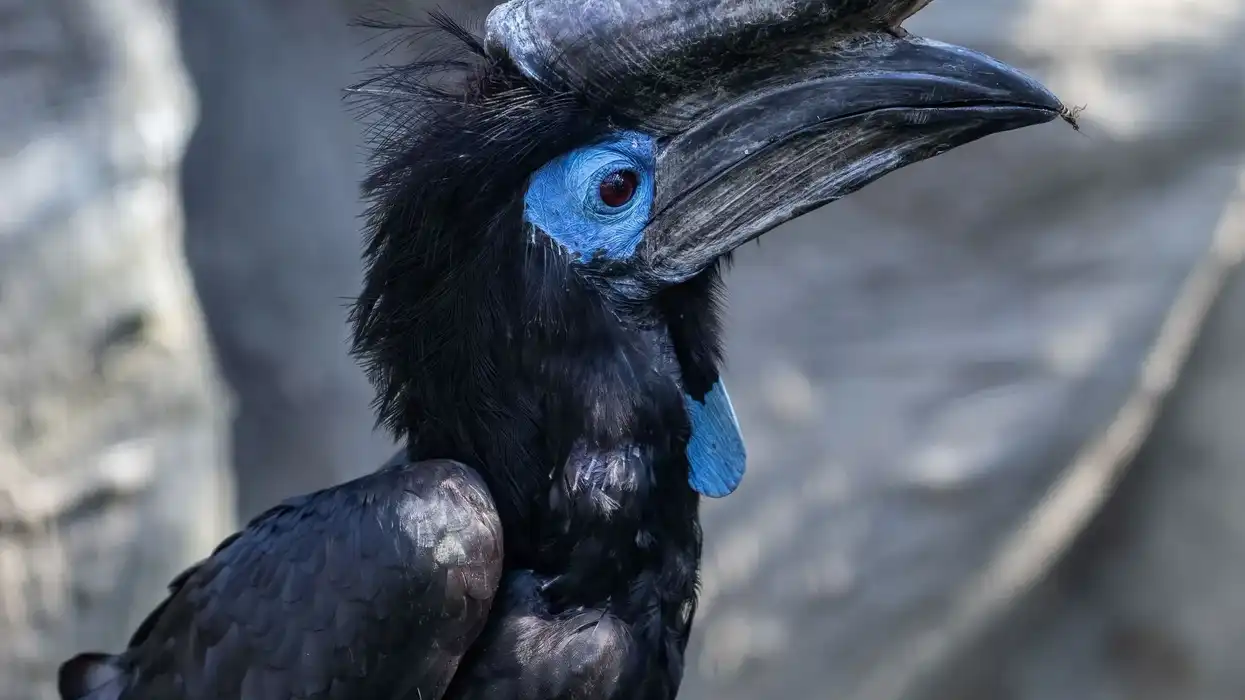There are a total of 15 species of crane in the world. The white-naped crane's scientific name is Antigone vipio.
The white-naped crane (Antigone vipio) is a member of the crane family. These cranes are extremely beautiful in appearance and endemic to Northeastern Mongolia, South Korea, Siberia, Japan as well as central China during winter to stay away from wintering grounds.
The white-naped crane (Antigone vipio) is omnivorous and feeds on both seeds, roots, plants as well as small vertebrates and rodents. Cranes are known for their upright posture and their beautiful colorations and pattern.
The white-naped crane is a popular symbol in Korea during the New Year. They are represented in both folklore as well as art. They are one of the tallest flying cranes and are found in most regions of the world except in South America and Antarctica, owing to the extreme climatic conditions in these places.
These cranes are similar to the red-crowned cranes but smaller in size. Read on for more!
For more relatable content, check out green heron and blue jay facts.
White-Naped Crane Interesting Facts
What type of animal is a white-naped crane?
White-naped cranes are types of crane birds that are silver-gray in appearance with certain parts light and others dark and stand tall.
What class of animal does a white-naped crane belong to?
A white-naped crane is a type of bird that belongs to the Aves class of species, family Gruidae and genus Antigone.
How many white-naped cranes are there in the world?
The population of the white-naped crane is listed at 6,250-6,750 cranes. There are only about 500-1000 individuals that stay in China during winters and about 5,750 population of cranes in Japan and Korea to move away from wintering grounds. They are seen migrating through the Korean peninsula.
Where does a white-naped crane live?
White-naped cranes prefer to live in wetland, grassy marshes, river valleys, grounds, and similar regions. They are endemic to Northeastern Mongolia, South Korea, Siberia, Japan as well as central China. They are seen migrating through the Korean peninsula.
What is a white-naped crane's habitat?
The white-naped crane's habitat constitutes wetland grounds where they can easily cover their offspring with little pasture available in the habitat. These cranes prefer residing in wetland regions where they can easily find appropriate food. During winter, these cranes travel to China near freshwater lakes, coastal flats, and farmlands away from wintering grounds.
Who do white-naped cranes live with?
Cranes are largely solitary cranes and come together only during the breeding season. The white-naped cranes form pair bonds and stay with their mate throughout their life. In the case of the Sandhill crane, they are monogamous and form pair bonds.
Once their mate dies, the surviving crane begins searching for another mate. They coexist with other wild animals. A group of cranes is called a herd.
How long does a white-naped crane live?
The white-naped crane's exact lifespan is not estimated. Males and females live about 15.1 years. The oldest crane is recorded to have lived 45 years.
How do they reproduce?
These cranes have a set of courtship rituals, including unison calling as well as dancing. Females start the call for the male. The female keeps her wings folded at her sides, and the male lifts his wings over his back.
The dance includes multiple displays, namely jumping, running, bowing, and grass tossing. Their breeding season is in the months of April to June. Mating happens by April.
Females lay two eggs per clutch in a period of two to three days. Both males and females are equally involved in building the nests by April for the young and raising them. The nest is not similar to smaller species of bird.
Their nest is made up roughly just to provide the chicks with shelter. Nesting sites may change throughout their life. Breeding parents are seen around the nest at most times to avoid attack from any predators near the nest.
The eggs are medium sizes, and the incubation period lasts 28-32 days. The juveniles are born featherless and are completely dependent on their parents in the initial few weeks. They learn to fly using their wings gradually.
What is their conservation status?
The white-naped crane conservation status is listed as Vulnerable by the International Union For Conservation Of Nature IUCN red list of threatened species. Loss of habitat is one of the major factors for their impacting their population. The International Union For Conservation Of Nature IUCN red list contains information related to conservation, population size, and other species as well.
White-Naped Crane Fun Facts
What do white-naped cranes look like?
White-naped cranes look extremely beautiful and have a white striped neck and a small head along with pinkish legs. They have long necks.
Their neck is long and moves along when they move from one place to another. Their pinkish legs are long and help them gain balance while standing. They have an overall silver gray, and white body plumage.
They have a red face patch near their eyes which highlights their dark eyes apart. Male and female species' bodies look more or less similar in appearance. They have a long beak attached to their head which they use to pick prey or food.
In some instances, males tend to be larger than females. Juveniles have brown to gray colored feathers and a light-colored throat, and small feet, legs, and bodies.

How cute are they?
The white-naped crane bird is extremely beautiful in appearance. The juveniles are extremely cute and adorable, although they are not as colorful. They migrate to different regions, including China during winter, to find alternative sources of food.
How do they communicate?
White-naped crane calls are high-pitched penetrating calls. These calls are loud and clear and can be heard from a distance, specifically during breeding season when they collectively occur various sounds and calls.
How big is a white-naped crane?
The white-naped crane height is 4 ft (125 cm) which is five times bigger than the common nighthawk, which is 0.7-0.8 ft (22-25 cm), and three times bigger than a pigeon.
How fast can a white-naped crane fly?
The white-naped crane flies at relatively good speeds. Cranes are known to fly at 25- 35 mph (40.2- 56.3 kph.).
How much does a white-naped crane weigh?
The white-naped crane weighs 12 lb (5.6 kg). Males tend to be slightly bigger in size as compared to females. This is observed clearly in mating/breeding pairs.
What are the male and female names of the species?
Male and females are not addressed differently. Males and females might differ in size and differ in reproductive functions.
What would you call a baby white-naped crane?
A baby white-naped crane is called a chick and is overall brown in color. The female lays two eggs. The chicks are slightly taller as compared to smaller species of cranes and attain more height as they grow.
Chicks are seen feeding on materials brought by their parents. They develop wings and feathers gradually and learn to fly using their wings in a few weeks. Young chicks remain in nesting sites until they are ready to live independently and are fed on seeds, roots, and vertebrates.
What do they eat?
These species' diet is primarily omnivorous. They are seen feeding on seeds, tubers, roots, and small vertebrates.
Roots, tubers, and seeds are seldom found, however, and hence they can be seen feeding on alternative sources of food to fulfill their diet requirements. These cranes feed on food available in their range and change their diet patterns based on their requirements.
Are they poisonous?
No, these species of birds are not poisonous. It's safe to see these species but from a safe distance. You could spot them in regions endemic to the species in wetlands marsh areas or in their breeding grounds where they raise chicks in large numbers. Major predators who are threats include hawks and eagles.
Would they make a good pet?
No, these cranes are innately wild birds and thrive best in their natural habitat. They can be spotted in different parts of the world and away from wintering grounds during certain parts of the year. Adult cranes stay around nesting sites during the breeding season.
Did you know...
Cranes are skillful fliers and are known to cover distances over the Himalayas. They are migratory birds and can reach heights of 16,000-26,000 ft. (4,900-8000 m). Their migratory pattern can drain them of all their energy to the point of causing death.
The crane sleeps on one leg, and its head is placed under its wings, and the other leg is drawn to its body. Most other species of smaller birds are seen resting in a sitting position.
The flag of Uganda displays a crowned crane, and it's a rare flag that bears a bird in it. Very few flags bear birds on them.
What's special about white-naped cranes?
The white-naped crane is a popular symbol in Korea. In the New Year, they are represented and showcased in both folklore as well as art. These birds symbolize happiness and eternal truth.
White-naped cranes have a silver-gray to white plumage. The adult birds are identified by their red face patch, which helps distinguish them from other species. Their juveniles are brown in overall appearance.
Are white-naped cranes endangered?
These species are listed as Vulnerable by the International Union For Conservation Of Nature's (IUCN) red list of threatened species. Hunting and poaching of such species are restricted to the point of being illegal.
All species of cranes are protected by an international agreement that protects birds. Habitat loss is a major threat that these species face; however, more efforts need to be taken to ensure that they get appropriate habitat to live and thrive.
Here at Kidadl, we have carefully created lots of interesting family-friendly animal facts for everyone to discover! Learn more about some other birds from our pelican facts and sanderling facts pages.
You can even occupy yourself at home by coloring in one of our crane bird coloring pages.









